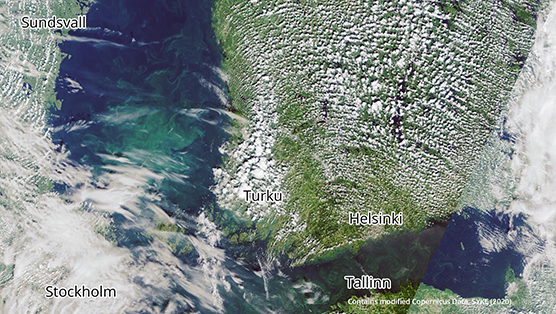Press release 2020-08-06 at 12:42

Satellite observation of the Baltic Sea on Wednesday the 5th of August. Cyanobacteria have been observed mixed in the water column or as surface accumulations in the open sea areas of the Bothnian Sea. Cloudiness complicates cyanobacterial observations in the Archipelago Sea. Surface accumulations can also be seen in the open sea areas of the western parts of the Gulf of Finland. Contains modified Copernicus data, SYKE (2020). See more in the
TARKKA web map application.
During the first week of August, the occurrence of cyanobacteria in the sea areas has been typical of the time. Observations of cyanobacteria at national monitoring sites have been made especially on the coasts of the Archipelago Sea, Bothnian Sea and Kvarken, and in the Gulf of Finland near Helsinki Metropolitan Area. In lakes, cyanobacteria have been observed less than average as in previous weeks. The inland cyanobacterial situation is typical of the time only in the regions of Southern Ostrobothnia, and both Northern and Southern Savonia. In many regions, unstable weather has prevented the formation of surface blooms. However, cyanobacteria that have been mixed within the water column, can rise to the surface again when the wind calms down.
Read more in Finnish
Report your algal bloom observations to the Järvi-meriwiki (Lake and sea wiki)
In the Järvi-meriwiki maintained by the Finnish Environment Institute, everyone has the opportunity to establish their own observation site and share algal bloom observations from lakes and coastal areas. Individual observations can also be sent while navigating different water bodies. You can also report observations using the smartphone-friendly Havaintolähetti website. The reported observations are shown on the national algal situation map, and they support the national algal situation assessment. Observations about the absence of cyanobacteria are also important.
Järvi-meriwiki is an online service produced in collaboration with authorities and citizens. The service provides basic information on all lakes larger than one hectare as well as different areas of the Baltic Sea. Users can share, for example, photos and other observations on the service.
Municipalities and cities monitor the cyanobacterial situation on the beaches, so it is advisable to report rich cyanobacterial blooms on beaches to the health authorities of the municipality in question.
Cyanobacteria observations also in the Itämeri.fi service
This summer, a website on algal bloom observations on the Itämeri.fi service is also launched. The cyanobacterial map presented on this algal bloom observations page combines the observations reported to the Järvi-meriwiki and from the beaches of the City of Helsinki as well as the observations based on satellite interpretations of the Finnish Environment Institute during the last three days.
This is how you identify cyanobacteria
A small amount of cyanobacteria in the water appears as green or yellowish particles. Narrow stripes of algae can drift to a beach. In calm weather, a substantial amount of cyanobacteria forms greenish or yellowish algal rafts and piles up in coastal water. Unlike cyanobacteria, pollen is found not only on the surface water but also, for example, on piers or yard furniture.
If the algae dissolve into tiny particles in the water when you touch it with a stick, it may be cyanobacteria. If the algae attache to the stick, it is something other than cyanobacteria. In a glass of water, cyanobacteria rise to the surface as tiny greenish particles within about an hour.
Algae bloom risk analysis
The risk of cyanobacterial blooms in the Finnish sea areas is considerable or moderate – the summer weather determines the actual situation (Press release June 4, 2020)
Information about algae situation
Satellite images
More information
(Telephone 1.00 - 3.00 pm)
Lakes
-
Researcher Laura Härkönen, Finnish Environment Institute SYKE, Tel. +358 295 251 009, firstname.lastname@ymparisto.fi
Sea areas
Cyanobacterial bloom situation
-
Senior Research Scientist Sanna Suikkanen, Finnish Environment Institute SYKE, Tel. +358 295 251 660, firstname.lastname@ymparisto.fi
State of the Baltic Sea
-
Head of Unit Vivi Fleming, Finnish Environment Institute SYKE, Tel. +358 295 251 879, firstname.lastname@ymparisto.fi (until 07/08)
-
Research Professor Markku Viitasalo, Finnish Environment Insitute SYKE, Tel. +358 295 251 742, firstname.lastname@ymparisto.fi (from 10/08)
Communications
- Communications Intern Sini Harvo, Finnish Environment Institute SYKE, Tel +358 295 252 184, firstname.lastname@ymparisto.fi